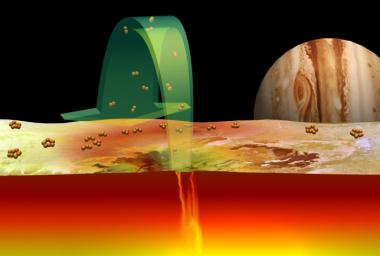
|
The Role of Sulfur in Io’s Volcanoes
- Click the image above for a larger view
- Full-Res JPEG (1225 x 827) (75.4 kB)
- Full-Res TIFF (1225 x 827) (1.6 MB)
Caption:
Current scientific ideas about the role of sulfur in volcanoes on Jupiter's moon Io are illustrated. Sulfur gas consisting of pairs of sulfur atoms (S2), detected above Io's volcano Pele by the Hubble Space Telescope in October 1999, is ejected from the hot vents of Io's volcanoes (green arrow). The sulfur gas lands on the cold surface, where the sulfur atoms rearrange into molecules of three or four atoms (S3, S4), which give the surface a red color. Eventually the atoms rearrange into their most stable configuration, rings of eight atoms (S8), which form ordinary pale yellow sulfur.
Background Info:
Additional information about the Hubble Space Telescope is available at http://www.stsci.edu/hst/ . Additional information about the Galileo mission is available at http://galileo.jpl.nasa.gov .
Cataloging Keywords:
| Name | Value | Additional Values |
|---|---|---|
| Target | Io | |
| System | Jupiter | |
| Target Type | Satellite | |
| Mission | Galileo | Hubble Space Telescope (HST) |
| Instrument Host | Galileo Orbiter | Hubble Space Telescope |
| Host Type | Orbiter | Space Telescope |
| Instrument | Photopolarimeter-Radiometer (PPR) | |
| Detector | ||
| Extra Keywords | Color, Volcano | |
| Acquisition Date | ||
| Release Date | 2000-05-18 | |
| Date in Caption | ||
| Image Credit | NASA/JPL/Lowell Observatory | |
| Source | photojournal.jpl.nasa.gov/catalog/PIA02547 | |
| Identifier | PIA02547 | |
